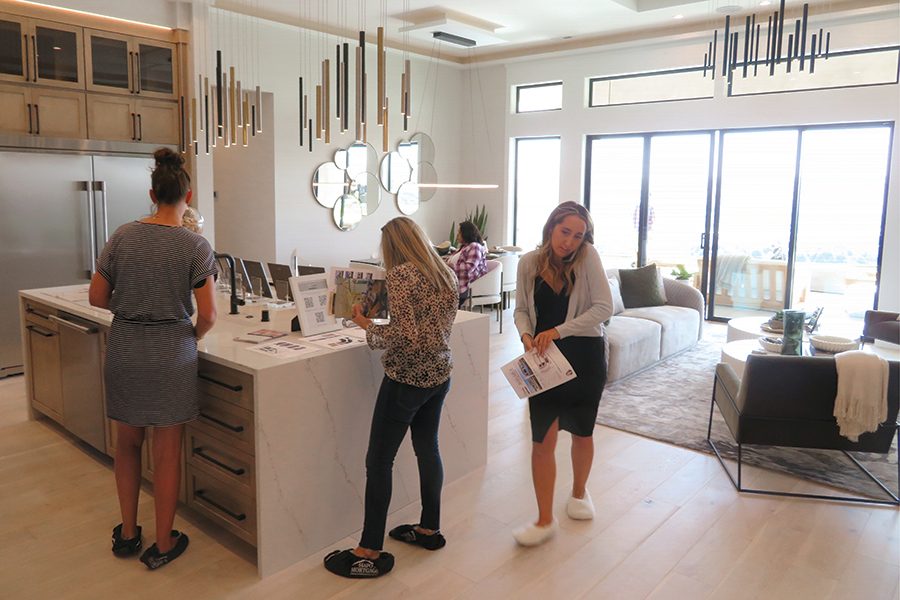
Home » Residential Growth: Homebuilding slows as interest rates, costs increase
Residential Growth: Homebuilding slows as interest rates, costs increase

October 17, 2022
Brett Lott, a Tri-City homebuilder, sat in the living room of the south Richland home his company built for the 2022 Parade of Homes.
He reveled in the steady stream of bootie-clad visitors wandering the house, peering into bedrooms and closets and cabinets.
There were challenges, but he was proud of the resulting home, with its 2,324 square feet, open floor plan, three bedrooms (plus den) and three-car garage.
The box beam ceilings and detailed carpentry around the stone fireplace were his favorite features.
The 2022 Parade was the first “regular” event since the Covid-19 pandemic forced the Home Builders Association of Tri-Cities to cancel the 2020 Parade of Homes and conduct the 2021 event behind masks.
Masks were optional for 2022 and even if Lott was one of only four builders open to in-person tours during the show (two homes offered virtual-only tours this year), the industry was ready to celebrate a return to normalcy.
Jeff Losey, president of the HBA, said his members were happy with the steady traffic of visitors, though he had hoped to see more. He looks forward to the coming year and is optimistic that by 2023, the Parade will feature a larger lineup of homes.
“We’re hoping to be back more to traditional numbers next year,” he said.
He is less optimistic about homebuilding in general.
Builders aren’t pessimistic, but they shy away from rosy projections.
A slower pace
The industry faces the usual lineup of culprits in 2022: mortgage interest rates are rising, building material costs are up by 20% and supply chain instability makes it difficult to anticipate when everything from refrigerators to transformers will arrive.
The result is a slowing in the pace of construction, even as demand remains constant, propelled by job and population growth.
Local homebuilders secured 864 permits for single-family homes by early September, according to HBA figures. That is 20% behind the five-year running average for the region.

Losey said summertime slowdowns are typical for the Tri-Cities. Families are busy with summer activities, not moving. If they are going to move into a new house, they don’t wait until summer to begin construction. They’ve usually planned to move in well before the first day of school.
“That said, we’re 20% off from where it was,” he acknowledged.
He’s heartened by a modest increase in the number of homes for sale. There were more homes for sale in August than a year prior. It’s still below the 1,200 or so needed to bring the market into balance but it signals a much-needed breather.
The market still favors sellers, though not as ardently as during the height of home price appreciation. Houses sell fast, but not as fast. Price reductions are more common. And Losey notes the return of open houses and “For Sale” signs in lawns – selling tools that weren’t crucial when homes sold on the day they listed.
“Demand may be waning, but it’s still there,” he said.
Losey anticipates homebuilding will continue at or below its current level into the coming year.
“I would expect it to be worse in terms of the number of permits pulled,” he said.
Challenges mount
The Federal Reserve has raised the federal funds rate – the interest rate it charges banks – five times in 2022. The cumulative total is three percentage points after the most recent three quarters of a percent hike in late September.
The last hike pushed interest rates for a 30-year mortgage to about 6.5%.
The U.S. Department of Labor pegs the inflation rate at 8.3%.
Despite the challenges, there are still too few new or existing homes offered to keep up with demand.
There were 550 homes for sale in early September, according to the Tri-City Association of Realtors. That’s more than the 300 or so on offer in early 2022, but still short of the 1,200 required for a balanced market.
Price drops are common and the time it takes to sell a home has grown to 22 days on average, up from 14 days last year, according to the Realtors association.
Gretl Crawford, owner of Gretl Crawford Homes, a boutique custom builder, said she intends to keep building about 10 homes per year. She doesn’t typically build the same home twice but is adapting by customizing plans to keep construction predictable.
She uses similar plans that can be customized.
“That’s the easiest thing to do is have a product that you already know what it costs, to market it and build it quickly,” she said.
The company also attempts to control costs by ordering all the construction materials when the project starts.
“We make all our decisions for the houses up front with the homeowners. We order everything at the beginning. Lock in the cost and have the products on hand,” she said.
Buildable lots
Interest rates, inflation and supply chain issues are not the only reason homebuilding has fallen behind.
Builders cite the cost and availability of buildable lots as a significant challenge.
Lott, answering why it is so difficult to build new homes that are in the affordable range, said land costs more. Purchasing a site, securing permits and sales taxes on construction total $300,000 before work even begins.
Crawford said it can cost $200,000 to buy a one-acre home site. Clients will ask if she can build for $800,000 or below, which is well above the Tri-City median price of $420,000 in August. The answer is no.
“The price of everything has gone up,” she said.
Crawford said her clients are typically people with Tri-City connections, who live here already or are moving for family. That gives her confidence that demand at the upper end will remain strong, though she expects some softness.
“There’s going to be more of a buyers’ market,” she predicted.
In Pasco, where new home permits are running nearly 50% behind the recent average, new subdivisions will offer a test of demand. The city is processing subdivision permits that will add more than 900 lots in western Pasco.
West Richland reports 4,200 homes, including apartments, are in the planning and development phase. That includes 3,000 in the future Lewis & Clark Ranch area on the west end of town.
In Kennewick, a 17-acre parcel between West 10th and West Clearwater avenues offers a telling look at a shift coming to the building industry.
D.R. Horton Inc., the $32 billion homebuilding giant from Fort Worth, Texas, is teaming with a local owner on a future neighborhood.
The site has been carved into 138 lots. Roads are in, as are utilities and even banks of mailboxes. The subdivision will be filled with duplexes, one way to keep land costs down.
The property is owned by an Othello-based development company but D.R. Horton has a purchase agreement, according to Benton County records.
D.R. Horton’s interest in the Tri-Cities has been rumored for at least a year, confirmation that the local community is gaining the attention of national builders. Its arrival could leave a mark on the most critical market, the one serving entry-level buyers.
In a recent investor presentation, D.R. Horton said 54% of the homes it sold closed for $350,000 or less.
Construction + Real Estate
KEYWORDS october 2022




